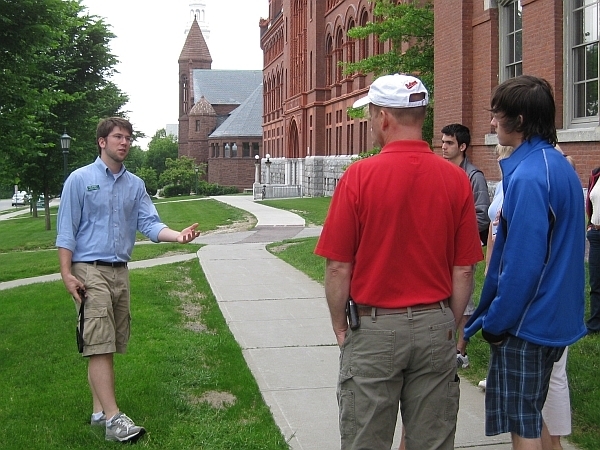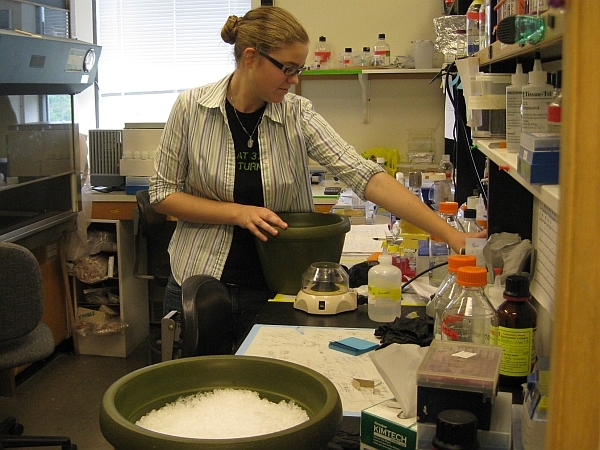UVM At A Crossroads

(Host) The University of Vermont is at a turning point. President Dan Fogel will step down next year after 10 years on the job. Fogel leaves a mixed legacy. He expanded enrollment, raised revenues, and led an aggressive building campaign on campus.
But he also failed to resolve UVM’s serious financial challenges. Even with steady increases in tuition, UVM faces a projected five year budget shortfall of $120 million. Layoffs are possible, and there are no easy options for new revenue.
This week, VPR’s John Dillon takes a look at Vermont’s flagship university at a crossroads.
(Crockett) "So I’ll start walking. I’ll be walking backwards almost the entire time we’re on tour."
(Dillon) A campus tour is part information session, part sales job. And Evan Crockett is effective at marketing the University of Vermont’s virtues.
For more than hour, the UVM senior leads a group of prospective students and parents in and out of a handful of buildings across the sprawling campus. The group peeks into a state-of-the-art biology lab.
(Crockett) "Every single one of these labs comes equipped with 24 inch IMacs which are less than a year old. So the technology in here is pretty much unparalleled."
(Dillon) Crockett’s backwards-walking tour goes by renovations to the Aiken Center, the new home for the Rubenstein School of Environment and Natural Resources.
(Crockett) "All right, going from one environmentally friendly building to the next, we’ll go into our student center; it is the only LEED gold certified student center in America."
(Dillon) The would-be students and their parents enter the Davis Center, a four story brick edifice that anchors the campus on Burlington’s Main Street. Crockett shows off one of the newest places to eat – a sushi bar.
(Crockett) "The university wanted authentic Japanese sushi, so not only did we get all of the Japanese rice makers and stuff like that, we actually went to Japan and hired three sushi chefs and brought them to the United States."
(Dillon) Crockett may be offering up some over-the-top marketing hyperbole, but his message goes to the heart of what UVM strives to be.
(Crockett) "You have this university, which has about 13,000 students, but it doesn’t feel that way – it feels like a small liberal arts college, which is what we started with. So you get that really intimate contact with your professors and peers that really don’t get at large universities. But you still get all the research opportunities."
(Dillon) And that’s UVM’s big selling point. In the competitive marketplace for quality students, UVM highlights its manageable size, its research focus, and its academic excellence.
Under President Dan Fogel, the school established an honors college. Selected students participate in undergraduate research and work closely with professors.
 Judy Contompasis is a senior in the biology department who’s working on a summer research project.
Judy Contompasis is a senior in the biology department who’s working on a summer research project.
(Dillon) She says the honors program brings together academically driven students, who live together in their own dorm.
(Contompasis) "And so it fosters this sense of – in some ways – an intellectual community, which is really cool because you’re reading the same things as the kids on your hall. So you get to – you know – have impromptu discussions pop up in the hallways sometimes about Foucault or Sartre, and it’s really cool."
(Dillon) But there are growing signs that the very things that make UVM unique – its manageable size, the ability to form close rapport between student and professor – are under increasing strain.
President Dan Fogel expanded the student body by 41 percent over 10 years. Additional students brought in more money, but the growth has also led to larger classes and overcrowding in the dorms. The most visible sign of Fogel’s legacy are the new buildings – including the Davis student center – that have sprouted on campus.
(Baruth) "I think he has had a very strong legacy, but also a very strongly flawed legacy. With Dan Fogel it’s always a question of size and scale."
(Dillon) English professor Philip Baruth has taught at UVM since 1993.
(Baruth) "So the things that he did when he got here were big things, and he brought the campus along with him. He increased the size and the quality of the student body. And he built a student center, a really nice student center. He also created an honors college, right out of nothing in a period of a few years."
 (Dillon) But Baruth says Fogel’s innovations were sometimes out of scale with what UVM or Vermont could afford. Consider the student center.
(Dillon) But Baruth says Fogel’s innovations were sometimes out of scale with what UVM or Vermont could afford. Consider the student center.
(Baruth) "It’s almost Egyptian in scale. And it created its own controversy where people thought it was wasteful, didn’t fit in with the campus, didn’t fit in maybe with Vermont values in terms of again size and scale."
(Dillon) Under Fogel, tuition has also increased steadily – the latest hike was 5.8 percent. That makes UVM one of the highest priced public universities in the country for in-state students.
(Wolf) "I kind of feel like us lower-middle class Vermonters have been left in the dust. I don’t feel like it’s accessible to us at all."
(Dillon) Samantha Wolf is from Vershire, in rural Orange County. She’s going to be a senior at Lyndon State College, where she’s majoring in sustainability studies, and managing the school’s greenhouse.
But when she graduated from high school in 2008 Wolf had her sights set on UVM.
(Wolf) "It was my first choice. I loved the area. Coming out of rural Vermont, I thought Burlington will have a lot to explore. And their programs of course were really astounding."
(Dillon) But facing a total cost of about $20,000 a year, Wolf says her lower middle class family could not afford a UVM education.
(Wolf) "When I realized that I was not able to attend because of my financial situation – I was excluded from UVM because I didn’t have enough money – I felt insulted, I felt crushed."
(Dillon) President Fogel says UVM’s high in-state tuition is balanced with relatively generous financial aid programs. He says over 80 percent of Vermont students have some level of financial aid totaling an average per student of roughly $10,000.
(Fogel) "While the sticker price remains high, the net cost to Vermont students after financial aid is very moderate here, lower than any other institution in Vermont, public or private."
(Dillon) But that wasn’t the case with Samantha Wolf. She faced the prospect of taking on significant loans because UVM didn’t offer much in financial aid.
(Wolf) "It wasn’t that much – it was like maybe $500 a semester – definitely not enough to put much of a dent in their tuition."
(Dillon) Fogel is a life-long academic who plans to return to teaching in the English Department when he steps down next year. But he’s also a veteran of campus leadership and campus politics.
Fogel speaks in slow professorial tones. And he says that, for him, the most significant part of his tenure is not what everyone sees – the building boom on campus.
(Fogel) "While those things are notable, what is most important is raising the profile of the university academically, raising its academic caliber, making it a destination point for a more highly qualified and more diverse student body, making it a more attractive place for excellent faculty to spend their careers."
(Dillon) Academic caliber is what first drew Evan Crockett here. The UVM senior and campus tour guide, says he was impressed by professors who really seemed to care about their students. And the school has not disappointed.
(Crockett) "And I think we’ve gone from being just a state school, to being a really prestigious university; where we’re bringing in top faculty from other places and doing ground breaking research."
(Dillon) Crockett acknowledges that there’s a price for the recent improvements, especially rising tuition bills.
(Crockett) "With improving and transforming the university, there’s cost. And I think unfortunately some people aren’t able to come here because of cost."
(Dillon) UVM’s rapid growth was also followed by a period of financial retrenchment, leading to lay-offs.
For Crockett, the trade offs from expansion of the campus and the student body have been worth it.
(Crockett) "We are a research university with the heart of a small liberal arts college. And that hasn’t changed, even through the budget cuts."
(Dillon) Today, UVM’s search for a new leader also includes a search for a new strategy – one that addresses increasing concerns about sustaining its dramatic growth, while preserving what may be its best selling point: its size and academic accessibility for students.
(Crockett) "Thank you for visiting today!"
For VPR news, I’m John Dillon.